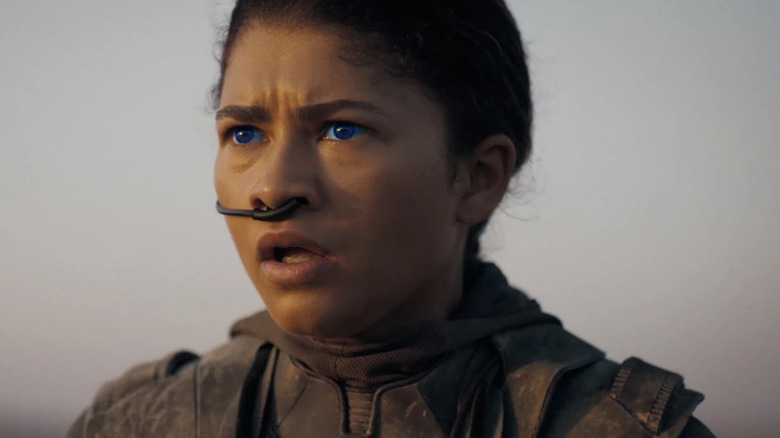Adjusting To Dune's Nose Pieces Came With Some Boogers For The Cast
The title planet in Frank Herbert's 1965 novel "Dune" is a desolate desert world, only survivable if one has access to a stillsuit. A stillsuit is a head-to-toe garment that captures every microscopic piece of moisture that exudes from the wearer's body, filters and recycles it, and stores it for drinking. Yes, you drink your own sweat, urine, and feces in a stillsuit. When used properly, a wearer could subsist on their own fluids for weeks. In the novel, stillsuits also covered the wearer's face and head, wicking moisture from their hair and pores.
In the various film and TV adaptations of "Dune," including in Denis Villeneuve's most recent versions, the mask portion of a stillsuit is often replaced by a single breathing tube that extends under the wearer's nose. The nasal tube presumably gathered saliva and mucous, although it seems inefficient, given that the bulk of human saliva escapes from the mouth. Although one can understand the aesthetic reason why a full-face mask was replaced by a single breathing tube; audiences would likely want to see the actors' faces, and actors likely don't want to work in masks.
The nasal tubes worn on the set of "Dune" weren't functional. The actors merely had to affix them to their faces and hope for the best. And, as one might imagine, many of the actors didn't find them terribly comfortable. Buzzfeed spoke to the cast of "Dune: Part Two," and each of them recalls having to get used to wearing stillsuit proboscises, and how it made their noses run. Warning: in the following slide, Zendaya will talk openly about her boogers.
Zendaya produces a lot of mucous
The use of schnoz pipes seems to have been pioneered by David Lynch's 1984 "Dune" adaptation, a visual note Denis Villeneuve lifted wholesale. In Villeneuve's film, the tubes are more pliable and rubbery, whereas Lynch's were plastic and textured. /Film, however, is not the place to ponder which "Dune" actors from the various adaptations looked best with snoot hydrants. That should best be left to fashion magazines that regularly comment on the Met Gala.
Zendaya reported that her tube required some getting used to, saying:
"You just kind of get used to it. Yeah, I think on the first film, I was only there for a week, and every day I was there I had snot in my nose. And I was like 'man how is everybody acting so normal?' I just couldn't get it positioned right and it kept falling out, but this time I was just like 'meh.'"
Anyone who has decided to wear an over-the-face mask or some elaborate makeup on Halloween night can likely relate. A first it can be suffocating and uncomfortable, but after a short while, everything starts to feel normal. Timothée Chalamet noted that he, too, was infected with aqueous nasal excretions, but it didn't take too long to become accustomed to his face. He said:
"You literally get used to it because the first couple of days with the nose piece, I found my nose would be running, it felt irritated. But by the end, it was like it felt weird to not have it."
No nasal health problems were reported from the set of "Dune: Part One" or "Dune: Part Two." It seems that, despite the boogers, everyone came out fine.

